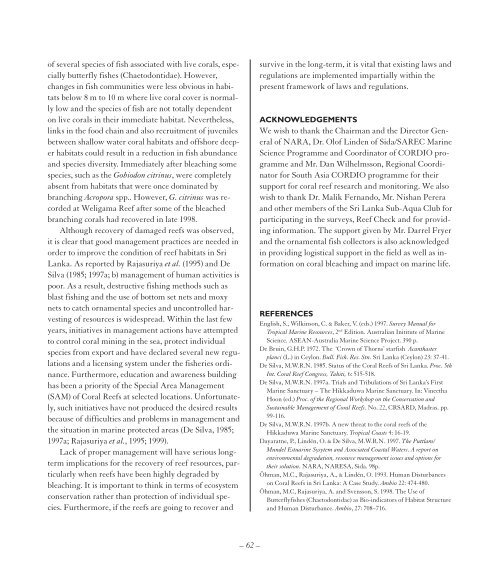Create successful ePaper yourself
Turn your PDF publications into a flip-book with our unique Google optimized e-Paper software.
of several species of fish associated with live corals, especially<br />
butterfly fishes (Chaetodontidae). However,<br />
changes in fish communities were less obvious in habitats<br />
below 8 m to 10 m where live coral cover is normally<br />
low and the species of fish are not totally dependent<br />
on live corals in their immediate habitat. Nevertheless,<br />
links in the food chain and also recruitment of juveniles<br />
between shallow water coral habitats and offshore deeper<br />
habitats could result in a reduction in fish abundance<br />
and species diversity. Immediately after bleaching some<br />
species, such as the Gobiodon citrinus, were completely<br />
absent from habitats that were once dominated by<br />
branching Acropora spp.. However, G. citrinus was recorded<br />
at Weligama Reef after some of the bleached<br />
branching corals had recovered in late 1998.<br />
Although recovery of damaged reefs was observed,<br />
it is clear that good management practices are needed in<br />
order to improve the condition of reef habitats in Sri<br />
Lanka. As reported by Rajasuriya et al. (1995) and De<br />
Silva (1985; 1997a; b) management of human activities is<br />
poor. As a result, destructive fishing methods such as<br />
blast fishing and the use of bottom set nets and moxy<br />
nets to catch ornamental species and uncontrolled harvesting<br />
of resources is widespread. Within the last few<br />
years, initiatives in management actions have attempted<br />
to control coral mining in the sea, protect individual<br />
species from export and have declared several new regulations<br />
and a licensing system under the fisheries ordinance.<br />
Furthermore, education and awareness building<br />
has been a priority of the Special Area Management<br />
(SAM) of Coral Reefs at selected locations. Unfortunately,<br />
such initiatives have not produced the desired results<br />
because of difficulties and problems in management and<br />
the situation in marine protected areas (De Silva, 1985;<br />
1997a; Rajasuriya et al., 1995; 1999).<br />
Lack of proper management will have serious longterm<br />
implications for the recovery of reef resources, particularly<br />
when reefs have been highly degraded by<br />
bleaching. It is important to think in terms of ecosystem<br />
conservation rather than protection of individual species.<br />
Furthermore, if the reefs are going to recover and<br />
survive in the long-term, it is vital that existing laws and<br />
regulations are implemented impartially within the<br />
present framework of laws and regulations.<br />
ACKNOWLEDGEMENTS<br />
We wish to thank the Chairman and the Director General<br />
of NARA, Dr. Olof Linden of Sida/SAREC Marine<br />
Science Programme and Coordinator of <strong>CORDIO</strong> programme<br />
and Mr. Dan Wilhelmsson, Regional Coordinator<br />
for South Asia <strong>CORDIO</strong> programme for their<br />
support for coral reef research and monitoring. We also<br />
wish to thank Dr. Malik Fernando, Mr. Nishan Perera<br />
and other members of the Sri Lanka Sub-Aqua Club for<br />
participating in the surveys, Reef Check and for providing<br />
information. The support given by Mr. Darrel Fryer<br />
and the ornamental fish collectors is also acknowledged<br />
in providing logistical support in the field as well as information<br />
on coral bleaching and impact on marine life.<br />
REFERENCES<br />
English, S., Wilkinson, C. & Baker, V. (eds.) 1997. Survey Manual for<br />
Tropical Marine Resources, 2 nd Edition. Australian Inititute of Marine<br />
Science. ASEAN-Australia Marine Science Project. 390 p.<br />
De Bruin, G.H.P. 1972. The ‘Crown of Thorns’ starfish Acanthaster<br />
planci (L.) in Ceylon. Bull. Fish. Res. Stn. Sri Lanka (Ceylon) 23: 37-41.<br />
De Silva, M.W.R.N. 1985. <strong>Status</strong> of the Coral Reefs of Sri Lanka. Proc. 5th<br />
Int. Coral Reef Congress, Tahiti, 6: 515-518.<br />
De Silva, M.W.R.N. 1997a. Trials and Tribulations of Sri Lanka’s First<br />
Marine Sanctuary – The Hikkaduwa Marine Sanctuary. In: Vineetha<br />
Hoon (ed.) Proc. of the Regional Workshop on the Conservation and<br />
Sustainable Management of Coral Reefs. No. 22, CRSARD, Madras. pp.<br />
99-116.<br />
De Silva, M.W.R.N. 1997b. A new threat to the coral reefs of the<br />
Hikkaduwa Marine Sanctuary. Tropical Coasts 4: 16-19.<br />
Dayaratne, P., Lindén, O. & De Silva, M.W.R.N. 1997. The Puttlam/<br />
Mundel Estuarine Sysytem and Associated Coastal Waters. A report on<br />
environmental degradation, resource management issues and options for<br />
their solution. NARA, NARESA, Sida. 98p.<br />
Öhman, M.C., Rajasuriya, A., & Lindén, O. 1993. Human Disturbances<br />
on Coral Reefs in Sri Lanka: A Case Study. Ambio 22: 474-480.<br />
Öhman, M.C, Rajasuriya, A. and Svensson, S. 1998. The Use of<br />
Butterflyfishes (Chaetodontidae) as Bio-indicators of Habitat Structure<br />
and Human Disturbance. Ambio, 27: 708–716.<br />
– 62 –


















